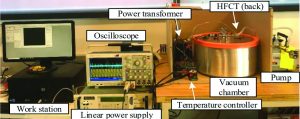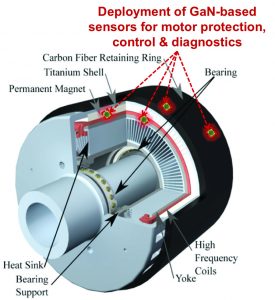Data Driven Approaches to Fault Tolerant Operation of Electric Machines
Yovahn Hoole with adviser K. Haran
While operating electric machines, a number of signals can be measured to aid with condition monitoring and machine control. However, the information within these signals is often hidden under noise and requires analysis to be useful. Here is where the emerging field of machine learning combines with our familiar field of machines and drives. Through its focus on motor prognosis and control, the Haran group works to combine a physical and electromagnetic understanding of electric machines with statistical analysis and machine learning to elucidate this hidden information. The group’s contribution has taken shape in two projects. The first works to autonomously quantify the quality and aging of winding insulation based on online monitoring of a host of signals, including partial discharge, resistance, capacitance and power-factor tip up. The second uses neural networks in conjunction with low-cost, Hall-effect sensors to replace resolvers in permanent magnet synchronous machines.

Figure 15: Experimental setup for winding-condition monitoring including pressure, temperature and voltage control. PC and oscilloscope monitor partial discharge activity.
Motor insulation diagnostics is an important problem to solve before the advent of fully electric aircraft. The plane’s low pressure, high humidity environment rapidly degrades winding insulation leading to earlier-than-expected failures. Current prognostic methods require either lengthy off-line testing, or are impeded by the variability in failure methods. Our group’s thrust focuses on improving current methods through the simultaneous online measurement of an ensemble of signals, including partial discharge, insulation resistance/capacitance and power-factor tip up. The non-linear relationship between the signals and their implications on insulation health are studied using machine-learning models. These models allow for the exploration of high-dimensional relationships between signals, robustness to noise, and the ability to work with or without a-priori knowledge. Currently, the group is developing a test bed, shown in Figure 15, to capture the above-mentioned signals using the winding developed for the group’s 1 MW motor.

Figure 16: Proposed model of GaN-based Hall effect sensors within 1-MW motor for condition monitoring and position estimation discharge activity.
The focus of the second project is on developing a low-cost, spatially constrained Hall-effect based rotor-position transducer. In state-of-the-art motor systems, the ability to monitor a motor’s state in a predictive fashion is limited by the system’s complexity and dynamic nature. Commercially available sensors cannot perform in such spatially constrained, and harsh environments due to signal-to-noise, manufacturing, and thermal limitations. In conjunction with Stanford University, the University of Arkansas and POETS, this project leverages miniature, temperature-tolerant sensors, neural networks, and the group’s high-speed MW-scale motor to replace bulky and expensive resolvers for permanent magnet synchronous machines. Small Hall-effect sensors are placed on the high-power-density 1 MW motor. The developed proof of concept (Figure 16) achieves an average error of 1.1 degrees electrical angle, and in 90% of cases has an error less than 2.5 degrees. Work is continuing to minimize the error and leverage the Hall-effects sensors’ embedded temperature-sensing ability to provide diagnostic information about the windings.